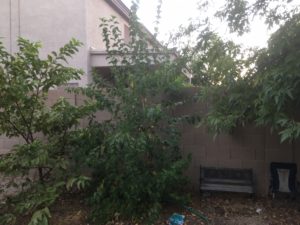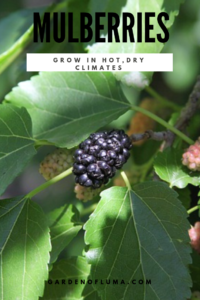Growing a Mulberry Tree in Hot, Dry Climates

As a kid growing up in Northern Michigan, we had a few mulberry trees nearby. I loved climbing the tree and beating the birds to the tasty mulberries. Mulberries tend to get a bad rap here in Arizona due to the pollens that can cause some to have severe allergy problems. Mulberries are typically a banned tree from many of the HOA communities here. The thing about mulberries is that it’s the male tree that causes the pollen problems, which doesn’t produce the wonderful mulberries. Mulberries do require a few chill hours or hours below 45 degrees Fahrenheit while they are dormant to produce fruit. Some of the varieties that do well in hot, dry climates are Pakistan, Dwarf Everbearing, Issai, Shagri La, and Peruvian.
Mulberries propagate really easily from cuttings so you can propagate more trees from your tree with ease.
You could probably just cut a branch and plant it directly into the ground and it will take root.
That’s how easy it is to propagate a mulberry.
Dwarf Everbearing Mulberry
I’m currently growing the dwarf everbearing mulberry variety.
Even though the tree is a dwarf, it still seems like if you allow it to grow without pruning, it can get pretty large.
After a couple years, mine is around 12 feet with pruning a few times throughout the year.
You can prune it to shape it into a tree, but it tends to take on more of a bush form, which I’m fine with.
The one thing I’m not a big fan of with this variety is the size of the berries. The berries can be really tiny on this variety.
I would recommend something like a Shagri La which produces berries that are more the size of a traditional Blackberry.
The Pakistan Mulberry produces really long berries. I wanted this variety because I knew how large some of the other varieties would get and I just didn’t have the room for it in my yard.
So, if your tight on space getting the dwarf is a good way to go.
The berries on this variety taste good, just would like them to be a little larger.
My kids really love picking mulberries, so if you have kids this is a great tree to get.

Fruit
Mulberries are sweet berries that have a similar look and taste to a blackberry. A mulberry tree fruits prolifically usually one time per year.
Fruiting season in my climate is around April, usually lasting about a month. Some mulberry trees will fruit periodically throughout the year, but generally its one major crop in the spring.
The size of the fruit can range from 1/2-inch to around 3-inches depending on the variety. It’s pretty common to get fruit right away, sometimes even in the first year.
Mulberry juice can stain your hands and clothing very easily, so be careful. There are some varieties that produce white berries that don’t stain.
Gardening Skill Level
I would rate growing mulberry trees in hot, dry climate as a beginner skill level.
This is one of the easiest fruit trees to grow in hot climates.
You basically stick it in the ground and watch it grow. It handles both the cold and heat with ease, requiring no special care.
This tree is a very rapid growing tree.

Suitable for Container Growing
I would recommend planting a mulberry tree in the ground.
Since they grow so rapidly, they’re just going to be happier in the ground.
Some dwarf varieties may do OK in a container like the dwarf ever bearing or Issai.
I attempted to grow a dwarf mulberry in a container, but it never really seemed happy.
I was constantly pruning it to try to keep it manageable, so from my experience, it’s a challenge to container grow.
If you do be prepared to prune it consistently and grow it in a well-draining soil mix.
Planting Tips

One of the best things about Mulberry trees for hot, dry climates is that you don’t have to worry about sun protection or frost protection.
This tree can pretty much be planted anywhere in your yard.
The one thing that I would consider when planting is that this tree grows rapidly and can get large.
It can make a great shade tree.
Even the dwarf mulberry can get pretty big.
This isn’t a tree I would put in a tight space or up against the house.
Watering
Mulberry trees like consistent watering throughout the year.
They aren’t overly demanding of water like some of my tropical fruit trees, but they also don’t necessarily like to go long periods without water.
I like to make sure that I’m deeply soaking the tree so the roots penetrate deeply into the soil.
Feeding
Mulberry trees aren’t hugely demanding of fertilizer needs.
It’s fine to use synthetic fertilizers throughout the year if you aren’t strictly organic.
I’ve occasionally used synthetic fertilizer on my tree.
I mostly use compost and occasionally fish emulsion and liquid seaweed.
Here are my product recommendations.
Sun Exposure
Mulberry trees can handle our full sun without really batting an eye.
There is no need to worry about shade protection with a mulberry tree.
In fact, if you put it in a spot that gets too much shade it will affect the fruit production.
Potential Problems
I have not had any problems with my mulberry tree.
Bugs seem to leave the tree alone and they seem to be pretty disease resistant trees.
Birds love mulberries, but typically the tree produces so many berries, there is enough to share with the birds.
You can use netting or other means to deter the birds away if preferred.
The bird poop after they eat the berries can be quite messy.
The tree does lose its leaves in the winter, so don’t be alarmed if it starts losing leaves late in the year.
It does periodically shed some older leaves throughout the year that turn yellow and drop.
If you see this, as long as you are watering properly, there is nothing to worry about.
Please comment below on anything you enjoyed from this post or your experience with growing mulberry trees in hot, dry climates.
